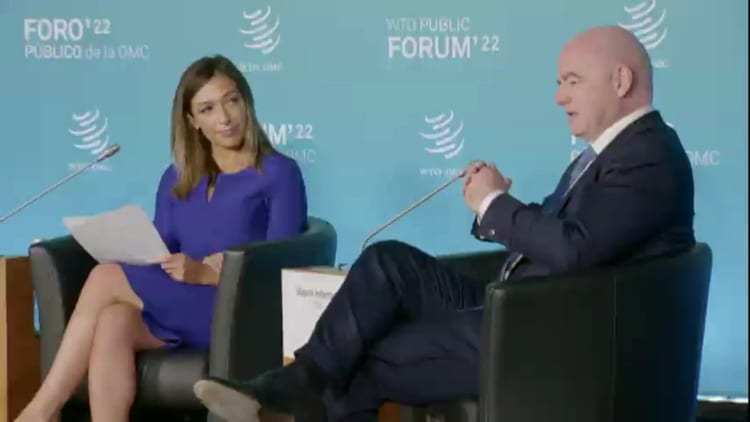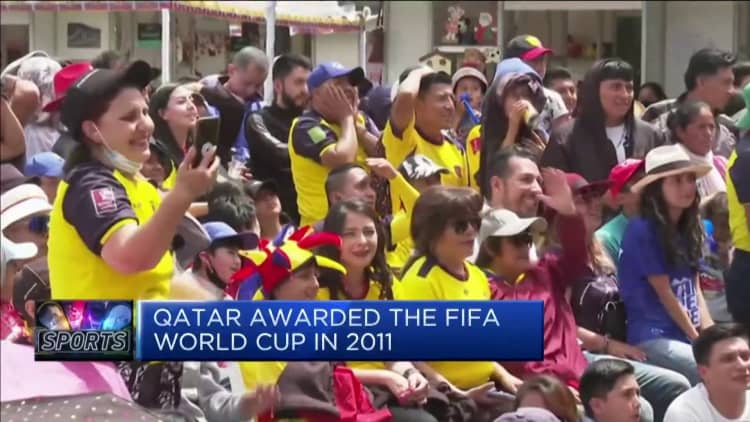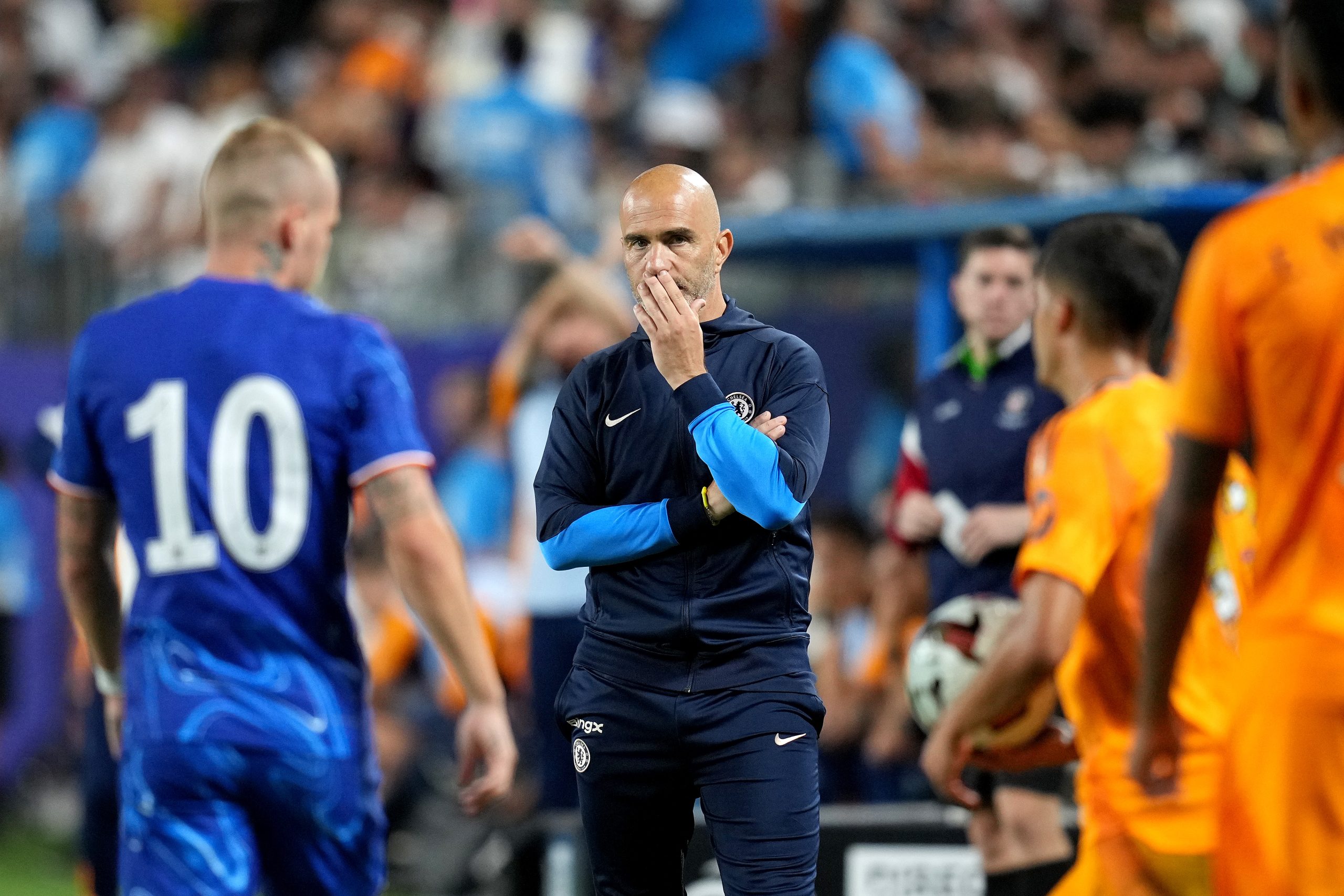Team USA celebrates after winning its match against Iran at Al Thumama Stadium in Group B play of the FIFA World Cup 2022 on Nov. 29, 2022.
Jabin Botsford | The Washington Post | Getty Images
The next World Cup will be the biggest ever after world soccer body FIFA took the leap from a 32-team field to 48 teams in 2026.
It means more of soccer’s so-called “little teams” that didn’t make it to Qatar will be given a chance of a lifetime when the tournament is hosted by the United States, Canada and Mexico.
That could be great news for everyone who was entertained by Saudi Arabia’s stirring upset of Lionel Messi’s Argentina at this World Cup, Japan’s two wins over former champions Germany and Spain or Morocco’s humbling of star-studded Belgium and Spain on its way to an unexpected quarterfinal run. More surprises surely await in four years.
Still, it’s not clear to everyone that bigger is better.
While 48 teams might increase the chances of fairytale moments such as Saudi Arabia’s 2-1 win over Argentina in the group stage, there’s also a good chance of the opposite: more one-sided games that may take some of the shine off a tournament that is meant to be the best vs. the best.
Spain 7, Costa Rica 0 also happened at this World Cup. As did England’s 6-2 rout of Iran, France’s 4-1 dismantling of Australia and Qatar becoming the first host country to lose its three group stage matches. FIFA will need to dig even deeper into the lower levels of international soccer to get from 32 to 48.
“It means that we will have to find 16 more good teams,” said Arsene Wenger, FIFA’s Chief of Global Football Development and a central figure in making a 48-team World Cup workable.

FIFA is still promoting the expansion as an upgrade and good for the global game. All continents will have more slots and FIFA says opening soccer’s marquee event to more of its 211 member countries or territories should have an impact beyond the teams, with the prospect of even more eyes on TV screens and more kids inspired to kick balls across the globe.
“I am convinced that if the teams, the countries have more opportunities to go to the world stage, it will do more for (soccer) development inside that country,” Wenger said.
Qatar’s World Cup is the first in the Middle East and the furthest FIFA has ventured from the game’s heartlands in Europe and South America. That decision has provoked its own harsh criticism but the on-field action might have been a timely advert for the 48-team plan, which FIFA announced in 2017 and has had to defend ever since over doubts about what the exact format will be.
FIFA initially indicated it would be 16 groups of three teams, but that idea was widely criticized. Another option could be 12 groups of four teams. Wenger said FIFA’s decision-making council has not decided yet.

In Qatar, Japan was one of three Asian teams to qualify for the last 16, which had never happened before. African teams collected more points in the group stage than ever. Morocco topped a group containing 2018 World Cup runner-up Croatia and semifinalist Belgium, and advanced to the quarterfinals by beating Spain on penalties on Tuesday. Cameroon signed off by beating Brazil, the first time an African team has conquered the five-time champion and soccer’s most celebrated team at a World Cup.
“Just look at how the World Cup is unfolding,” said Senegal coach Aliou Cisse. “It’s not like 30 years ago when the big fish were completely eating the little fish alive.”
Amid Japan’s run in Qatar, winger Takefusa Kubo said “they can’t underestimate Asia.” Ghana coach Otto Addo said Africa deserves its extra places and its teams now have a better chance of going further.
However, the expansion may not have much of an impact on the final outcome of the World Cup.
European and South American teams — the big fish Cisse referred to — have gobbled up every one of the 21 World Cup titles so far, with 12 for Europe and nine for South America. No teams from another continent have made a final in nearly 100 years of World Cup history. Eighty-two out of 84 semifinalists have been European or South American. The United States in 1930 and South Korea in 2002 are the exceptions.

In Qatar, while teams from outside Europe and South America did well in the group stage, only Morocco advanced to the quarterfinals, where it will face Portugal on Saturday. South Korea, Japan, Senegal, the United States and Australia were all eliminated in the round of 16.
Cisse’s Senegal are the African champions but were outclassed 3-0 by England. South Korea, ranked No. 3 in Asia, was knocked out 4-1 by Brazil. South Korea forward Son Heung-min, his country’s one star, said almost in envy: “Look at their players.”
A bigger World Cup does offer clear advancement opportunities for FIFA, though.
Just over 3.5 billion people, more than half the world’s population, watched the 2018 World Cup in Russia, according to FIFA, and the soccer body earned record revenues of $7.5 billion from commercial deals tied to the Qatar World Cup.
With those numbers in the bank from a 32-team tournament, 48 offers the obvious chance to sell World Cup aspirations to more people in more places.





















Discussion about this post